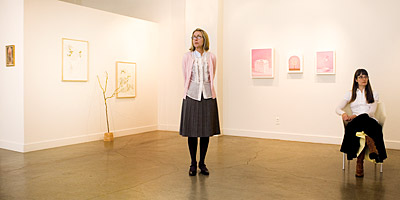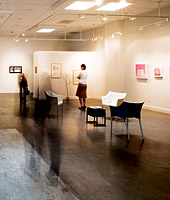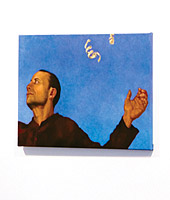Beyond the Bounds
Faculty artists exchange earthly limitation for hopeful expectancy

As director of SPU's Art Center Gallery, Laura Lasworth says she likes to explore different ways of storytelling with each new exhibition.
By Reece Carson [reece@spu.edu]
Photo by Daniel Sheehan
“Art can help us realize we’re not alone, that something ‘other’ can break in to make a difference in our lives.”
Two paintings hang near each other against a stark white wall. In one, a wide-open window reveals an endless horizon of blue waves. In the other, a man dressed in crimson studies something beyond the picture’s border, out of sight of the viewer.
Painted by different artists, at first glance the simple landscape and the elusive
figure couldn’t be more different. Yet a second look reveals subtle connections.
In both pieces, there is expectancy: the swelling waves as yet devoid of boats and birds; the man captivated by the unknown. And then there are the colors.
Streaks of white, cerulean blue, and dashes of gold in each painting open up a dialogue between the works,” says Laura Lasworth, professor of art at Seattle Pacific University and director of the Art Center Gallery.
“And that can cause viewers to linger, to experience a moment of transcendence where the art pushes into our reality.”
Such moments often touch people’s souls, notes Lasworth. They can also reveal new possibilities — possibilities that carry with them a sense of hope. “Art can point beyond our fixed notions,” she suggests. “It can help us realize we’re not alone, that something ‘other’ can break in to make a difference in our lives.”
The idea to create an art exhibit exploring the theme of hope first occurred to Lasworth in 2006. That’s when she learned that Jürgen Moltmann — author of Theology of Hope — would be SPU’s guest for the 2007–08 Day of Common Learning.
“I decided to see if we could create an exhibit that would fit well with Moltmann’s visit,” says Lasworth. “It seemed like a great way to involve the art faculty.” The event would also celebrate the re-opening of the Art Center Gallery, renovated during the summer of 2007.

The newly renovated Art Gallery at SPU helps showcase professional works to the campus and Seattle communities. |
To prepare for the exhibit, Lasworth and colleagues such as Katie Kresser, assistant professor of art history, and Karen Gutowsky-Zimmerman, associate professor of visual communication, read Theology of Hope. Moltmann’s seminal work led to ongoing dialogue among the faculty members.
“We discussed how hope is communicated through stories,” says Gutowsky-Zimmerman. “In a visual culture, every dot, line, and shape conveys meaning. It makes me very aware that I want the visual stories I tell to communicate Christ’s hope.”
Central to their conversations was Moltmann’s discussion of the “narrow way” of hope and the twin dangers of presumption and despair. “The presumptuous person assumes that everything is going to turn out exactly the way he or she plans,” Kresser explains. “The despairing person basically assumes nothing is going to change, no matter what he or she does. Both are based on frozen notions of the way the world operates; both deny God’s freedom and sovereignty.”
Hope transcends such limits, says Lasworth. The ultimate example of this, she notes, is found in Jesus’ resurrection: By transgressing the boundaries of death, Christ brings a new dimension of hope to our reality through his promise of limitless life. Likewise, art that is hopeful tends to break through our sense of rigid boundaries, such as in a painting where a figure engages with something beyond the border of the canvas.
With these thoughts in mind, Lasworth collected potential works for the exhibit from SPU’s full-time and adjunct art
faculty during the summer of 2007. Then, in September, she
collaborated with Kresser and Christen Mattix, assistant professor of art, to assemble the show.
“We spent a day pairing pieces, moving them around in the gallery, and noting narrative lines and where continuities in themes and colors occurred,” says Lasworth.

"Revelation" by Suzanne Brooker. |
The title of the exhibit, Hope: Open/Closed, materialized
after Kresser noticed that the artists used formal qualities of opening (unobstructed borders and spaciousness) and closing (frames within frames) to suggest “a fullness that can’t be comprehended by mere marks on canvas or paper,” she says.
Along with such glimpses “beyond the bounds,” colors also helped weave the show together. Many of the pieces used blue, traditionally a symbol for heaven. Coupled with the Emily
Dickinson line “heaven does not change her blue,” the continuity of blue allowed Lasworth to create a visual presence in the exhibit that subtly invoked eternity. Against this foundation,
reds and pinks, like touches of daybreak, were blended to convey another aspect of hope found in Moltmann’s work: the joyful promise of the future.
In the end, the exhibit, which ran September 24–October 26 and included 19 works of art, bore witness to the freedom, fullness, and spontaneity of hope, not only through the pieces, but also in how the show came to be.
“There was a certain synchronicity that occurred in the exhibit,” explains Lasworth. “We were surprised at how well it all looked together. The art and our ideas definitely came together to create a larger dialogue.” And, in that, the faculty encountered its own moment of transcendence.
See more works from the SPU Art Center Gallery exhibit Hope: Open/Closed.
Return to top
Back to Features Home
|